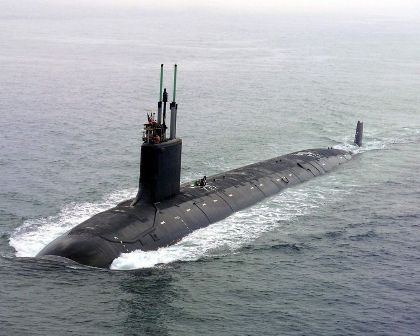Virginia-class (SSN-774)
Summary
| Origin country | 🇺🇸 United States |
| Category | Submarine |
| Subtype | Nuclear attack submarine |
| Manufacturer | General Dynamics Electric Boat, Huntington Ingalls Industries, , Newport News Shipbuilding |
| Year commissioned | 2004 |
| Units |
SSN-774 USS Virginia SSN-775 USS Texas SSN-776 USS Hawaii SSN-777 USS North Carolina SSN-778 USS New Hampshire SSN-779 USS New Mexico SSN-780 USS Missouri SSN-781 USS California SSN-782 USS Mississippi SSN-783 USS Minnesota SSN-784 USS North Dakota SSN-785 USS John Warner SSN-786 USS Illinois SSN-787 USS Washington SSN-788 USS Colorado SSN-789 USS Indiana SSN-790 USS South Dakota SSN-791 USS Delaware SSN-792 USS Vermont SSN-793 USS Oregon SSN-794 USS Montana SSN-795 USS Hyman G. Rickover SSN-796 USS New Jersey |
| Current operators | 🇺🇸 United States |
Description
The SSN-774 Virginia class submarine, also known as the Virginia-class attack submarine, is an advanced and highly versatile naval vessel designed for a range of missions. Developed by General Dynamics Electric Boat and Huntington Ingalls Industries, this class of submarines has gained widespread recognition for its cutting-edge technology and exceptional performance.
The Virginia class submarines feature a length of approximately 377 feet and a beam of 34 feet, allowing for stealthy movement and enhanced maneuverability in various underwater environments. With a submerged displacement of around 7,800 tons, these submarines are capable of diving to depths of more than 800 feet.
Equipped with powerful nuclear propulsion, the Virginia class submarines have an extended range and endurance, enabling them to operate for extended periods without refueling. This advanced propulsion system also ensures quiet operation, making these submarines incredibly difficult to detect, thus enhancing their effectiveness in covert operations.
The Virginia class submarines boast a range of innovative features, including advanced sonar systems, stealth design, and sophisticated electronic systems. The submarines are armed with torpedo tubes and can accommodate Tomahawk cruise missiles, enabling them to engage both surface and underwater targets effectively. Additionally, these submarines can also be deployed for intelligence gathering, reconnaissance, and surveillance missions.
Another notable aspect of the Virginia class is its modular design, which allows for rapid upgrades and integration of new technologies. This feature ensures that the submarines remain at the forefront of technological advancements and can adapt to evolving naval requirements.
Coined as the "submarine of the future," the Virginia class exemplifies the United States Navy's commitment to maintaining superiority in undersea warfare capabilities. With its advanced features, unmatched stealth, and operational flexibility, the Virginia class continues to play a crucial role in enhancing the United States' maritime strength and security.
Technical specifications
| Displacement | 6930 tons |
| Displacement submerged | 7700 tons |
| Range | Unlimited, except by food supplies |
| Endurance | Limited only by supplies |
| Crew | 135 members |
| Width | 10.0 m (32.8 ft) |
| Length | 115.0 m (377.3 ft) |
| Max. depth | 500 m (1640.4 ft) |
| Propulsion | 1 General Electric S 9G reactor with a power of 40,000 hp - 1 pumpjet |
| Armament | 12 T/CLS Mk.45 (12 Tomahawk) + 4 533mm TLTs (26 Mk.48 or Sub-Harpoon) |
| Maximum speed | 25 knots |
| Max. speed submerged | 34 knots |

